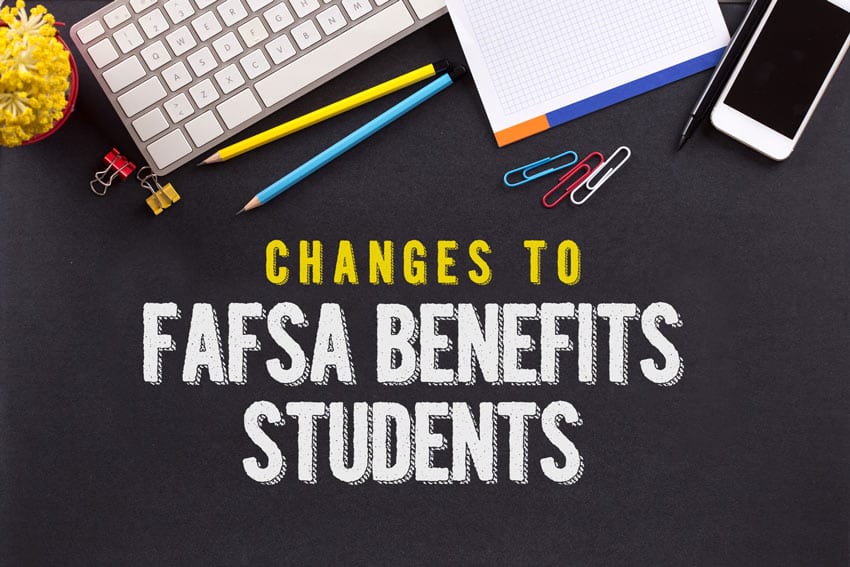You’re a college student, and life feels grand. You have your classes picked out for next semester, and you’ve signed a lease through next year. Everything is falling into place. The last thing on your mind is filling out the Free Application for Federal Student Aid, commonly known as FAFSA.
It should be the first.
You need to know about the two significant changes to the FAFSA application, which have already have gone into effect for the 2017–18 academic year.
First of all, the application process timeline has changed. In the past, students had to wait until January 1st to begin applying. This year, the financial aid application process opened on Oct. 1st, which offered students an extra three months to apply. In the future, this October date will remain.
Now that the process starts in October, FAFSA will cite the tax year 2015, as opposed to 2016, as it would have been under the old system. So for the 2017–18 academic year, FAFSA will use the 2015 federal tax return information in what is called the “prior-prior year policy,” or PPY.
That means students no longer need to wait for their parents to file income taxes for the current year before filling out their FAFSA application. It’s a win-win for students and financial aid offices alike. FAFSA applications will come in earlier, and students will be able to view the benefit packages they receive from colleges earlier.
Federal Aid Is First Come, First Served
Why is this important news? Much of the financial aid handed out using your FAFSA information is given on a first come, first served basis. Thus, the earlier you fill out FAFSA forms, the better your chances of receiving larger benefits.
For Damian Breland, a junior studying criminal justice at Florida A&M University, the change in start date meant a change to his yearly routine. He said, “Usually I would have to wait until my parents filed their taxes every year (typically March or April) before I could fill out my FAFSA. When I heard about the changes, I set a reminder on my phone for October 1st. It was nice to be able to get it out of the way early.”
More Time to Plan for Costs and Choose a College
This date change is also a benefit to high school seniors. They now have the ability see their financial aid packages before choosing a college, giving them the advantage of shopping around to see where the best deal is.
However, it is still up to the colleges to send their award offer in time. FAFSA moved up its deadline, but that doesn’t mean all the colleges will follow suit.
“If institutions decide to [offer packages to] students earlier, it will benefit students,” said Som Chatterjee, the Senior Associate Director of Student Financial Aid at Florida State University. “That is especially so for incoming students who will now have additional time to evaluate their financial aid packages and make better-informed decisions.”
Breland agrees, but still holds reservations about the PPY policy.
He said, “I like it because it means I can see how much money I get sooner, so I can start budgeting for next year,” he said. “The only thing I’m worried about is what happens if my family’s income changes. I may need more aid than what is shown in my parent’s tax return from two years ago.”
Of course, there is a solution. And it turns out that this is not a new issue.
Chatterjee explained, “Just like in previous years, students who have had an income change can submit documentation substantiating their change of income for review by the Financial Aid office.”
“If approved, adjustments can be made so that the information on their financial aid application (FAFSA) matches the current financial aid situation.”
The Free Application for Federal Student Aid is, as its name implies, free. Every college student should fill one out. There is nothing to lose and a whole lot to gain. In the 2013–2014 school year alone, there was $2.9 billion in unused federal grant money.
“It’s really the only way for me to pay for school,” said Breland. “It’s important because if you don’t apply for the aid, you won’t have any money to rely on. For people that can’t pay out of pocket, you’re looking into taking out student loans and those can add up real quick.”
Getting Started with FAFSA
To get started, visit fafsa.ed.gov and fill out an application.
If you are new to FAFSA, you will need to create an FSA ID. In 2015, FAFSA started using the FSA ID instead of a four-digit PIN to improve security. You no longer need to provide your social security number or date of birth at each login.
If you are returning to FAFSA, you still need to update the application each year you want to receive benefits, so keep your FSA ID handy.
Make sure you select the correct academic year and have your paperwork ready: social security number, driver’s license, federal tax returns, W-2 forms, and current bank and investment statements from both you and your parents.
The deadline for filing varies, but to receive student loans and federal grants, you must submit your FAFSA by June 30.
After getting accepted to a college, you will receive your awards from that school. Usually, awards are offered sometime in the spring, but schools that are trying to lure early enrollees may begin sending them before the holidays.
Sources:
- Imam, M. (2015, January 20) $2.9 billion unused federal grant awards in last academic year. Retrieved from http://college.usatoday.com/2015/01/20/2-9-billion-unused-federal-grant-awards-in-last-academic-year/


















